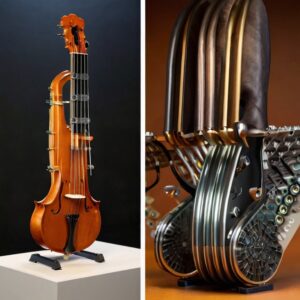In classical music, tradition often holds a sacred spot, particularly in the instrument design and construction. As we steer through the 21st century, a bold wave of innovation is transforming how classical music instruments look, feel, and, most importantly, sound. Modern luthiers and manufacturers, armed with a blend of reverence for tradition and a zeal for advancement, are at the forefront of this revolution. From the storied workshops where violins and cellos are born to the high-tech labs designing wind instruments, a new chapter in the evolution of musical instruments is being written.
Exploring New Horizons with Materials

The exploration of new materials in the classical music instrument manufacture marks a shift in the traditional approach to crafting these intricate pieces. Beyond the scarcity and sustainability concerns associated with conventional woods like maple, spruce, and ebony, the venture into alternative materials reflects a broader movement towards innovation and adaptation in the classical music world. Carbon fiber, in particular, has gained a reputation not only for its practical benefits—such as an exceptional strength-to-weight ratio and an unparalleled resistance to changes in temperature and humidity—but also for its potential to reimagine the tonal possibilities of classical instruments. The precise acoustical engineering afforded by carbon fiber technology allows for the fine-tuning of instruments to achieve a purity of sound that rivals, and in some instances surpasses, that of their wooden counterparts. The durability of carbon fiber instruments presents a compelling advantage, offering musicians the possibility of performing in a wider range of environments without the fear of damage to their precious instruments. This innovative approach caters to the practical needs of musicians and aligns with a contemporary aesthetic sensibility, making classical music more accessible and appealing to a younger, more diverse audience. The incorporation of carbon fiber into instrument design is emblematic of a larger trend towards embracing modernity while preserving the timeless essence of classical music, opening up a new horizon in the evolution of musical performance and craftsmanship.
The Marriage of Form and Function
The intersection of form and function in the design of classical instruments is witnessing a revolutionary transformation, as modern luthiers merge traditional craftsmanship with cutting-edge innovation. They are content with replicating the esteemed models of the past but are fervently probing the depths of design and acoustics to elevate the playing experience and sound projection capabilities of their creations. These inquiries into ergonomics and structural acoustics are driven by a desire to surmount the limitations imposed by traditional designs, making instruments that are not only easier and more comfortable and capable of delivering superior sound quality in the increasingly complex acoustic environments of contemporary concert venues.
The application of technology, particularly through the use of Computer-Aided Design (CAD) software, has been importantl in this modern renaissance of instrument design. CAD technology offers luthiers a virtual canvas on which to experiment with subtle modifications in shape, size, and structure without the immediate need to produce a physical model. This means that iterations can be made quickly and efficiently, exploring a vast array of design possibilities with a precision that manual drafting could never achieve. These digital models can then be subjected to simulations that predict how changes in design will affect an instrument’s sound production and dissemination, guiding luthiers in making informed decisions about modifications that would enhance sound quality and player interaction.
This digital approach has facilitated the exploration of innovative structures that aim to project sound more effectively in large or acoustically challenging spaces, such as vast modern concert halls. Through the manipulation of an instrument’s geometry, the distribution of its mass, and the optimization of its resonance chambers, designers can significantly influence how sound waves propagate, ensuring clarity and richness of tone at greater distances. This marriage of form and function, buoyed by technological advancement, represents a thrilling advancement in the field of musical instrument design. It preserves the artistry and heritage of traditional luthiery and propels it into a future where instruments are more adaptable, resilient, and sonically pleasing than ever before.
Integrating Technology with Tradition
Perhaps the most futuristic aspect of instrument innovation involves the integration of digital technology. While electronic elements have long been a part of modern music, they are now making their way into classical instruments in fascinating ways. MIDI (Musical Instrument Digital Interface) capabilities are being incorporated into traditional instruments, allowing them to communicate with computers and synthesizers. This opens up a world of possibilities for composers and performers, enabling them to blend classical sounds with electronic effects, amplification, and recording techniques directly from their acoustic instruments.
Silent practice systems are becoming increasingly popular among players of string instruments. These systems allow musicians to practice silently using headphones, with the sound of the instrument being captured by sensors and converted into digital signals. This technology is beneficial for practicing in noise-sensitive environments and provides a platform for experimenting with digital effects and recording.
Sustainability and Ethical Manufacturing
Innovation in classical music instruments is about advancing the art form; it’s also about sustainability and ethical manufacturing. The overharvesting of certain woods traditionally used in instrument making has raised serious environmental concerns. Luthiers and manufacturers are now actively seeking sustainable materials that minimize the ecological footprint of instrument production.
Bamboo, with its rapid growth rate and excellent acoustic properties, is being explored as a material for woodwind and even string instruments. Efforts are being made to source wood and other materials from certified sustainable sources, ensuring that the creation of beautiful music does not come at the expense of our planet.
The Symphony of Progress
The landscape of classical music instrument manufacturing is richer and more varied than ever before. Traditional craftsmanship, honed over centuries, is being augmented with cutting-edge materials, design philosophies, and digital technology. This synergy between the old and the new is not just transforming the instruments themselves; it’s revitalizing the whole classical music ecosystem, from composers and performers to educators and audiences.
The challenge for modern luthiers and manufacturers is not just to innovate for innovation’s sake but to do so in a way that respects the traditions and needs of classical music. This careful balance between reverence for the past and ambition for the future is what will continue to propel classical music into new realms of artistic expression. Just as the composers and virtuosos of past centuries pushed the boundaries of music in their time, today’s instrument makers are laying down the foundations for the next era of classical mastery. The symphony of progress continues, and the future of classical music looks brighter—and more innovative—than ever.
